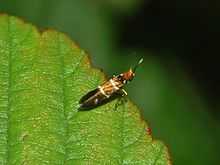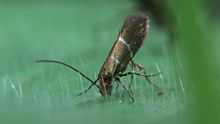Micropterix aruncella
| Micropterix aruncella | |
|---|---|
 | |
| Micropterix aruncella | |
 | |
| Scientific classification | |
| Kingdom: | Animalia |
| Phylum: | Arthropoda |
| Class: | Insecta |
| Order: | Lepidoptera |
| Family: | Micropterigidae |
| Genus: | Micropterix |
| Species: | M. aruncella |
| Binomial name | |
| Micropterix aruncella (Scopoli, 1763) | |
| Synonyms | |
| |
Micropterix aruncella is a species of moth belonging to the family Micropterigidae. This is one of the best known members of the family, being found in a wide range of habitats from sea level to over 2,000 metres (6,600 ft). The only habitat not favoured by this species is dense woodland. It is distributed throughout Europe except the Iberian Peninsula.[1]
Description
This very small moth has a maximum forewing length of only 4 millimetres (0.16 in). Their wingspan is 6 millimetres (0.24 in) or 7 millimetres (0.28 in).[2] The colour of the forewings is rather variable but is usually reddish golden. Females usually have no other markings but males are marked with two silvery white bands.[3]
Habitat
They can be found in various dry habitats including downland and hillsides.[2]
Ecology

Like other members of the family, this species has functional jaws and it feeds as an adult on pollen grains from a wide variety of flowers including those of Crataegus, Cytisus, Lychnis, Pinus, Plantago, Rosa, Urtica and Veronica as well as numerous grasses. Depending on elevation and latitude, the adults may be encountered in daytime from May to August.[2]
The larva feeds on detritus before pupating in a tough cocoon.
References
- ↑ "Micropterix aruncella (Scopoli, 1763)". 2.6.2. Fauna Europaea. August 29, 2013. Retrieved November 12, 2013.
- ↑ 2.0 2.1 2.2 "Micropterix aruncella". Retrieved February 27, 2013.
- ↑ "Micropterix aruncella". UK Moths. Retrieved February 27, 2013.
Further reading
- Zeller-Lukashort, H. Christof; et al (2007). "A review of Micropterix Hübner, 1825 from northern and central Europe (Micropterigidae)" (PDF). Nota Lepidopterologica 30 (2): 235–298.
External links
| ||||||||||||||||||||||||||||||||||||||||||||||||||||||||||||||||||||||||||||||||||||||||||||||||||||||||||||||||||||||||||||||||||||||||||||||||||||||||||||||||||||||||||||||||||||||||||||||||||||||||||||||||||||||||||||||||||||||||||||||||||||||||||||||||||||||||